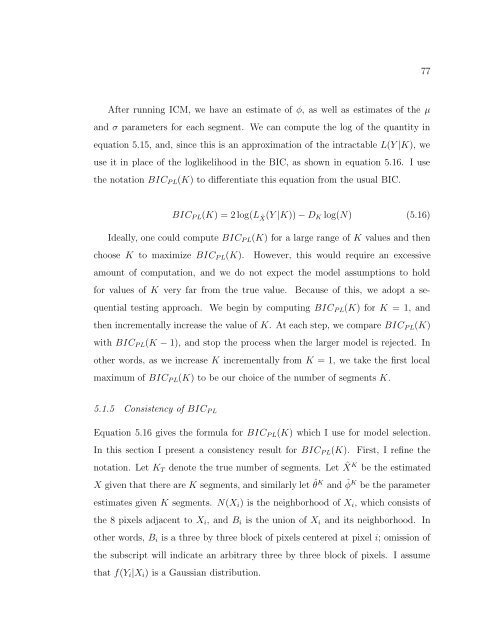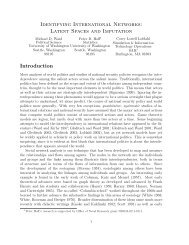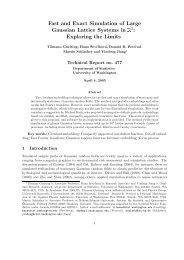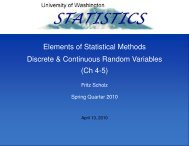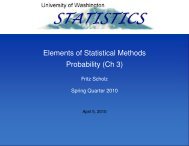View - Statistics - University of Washington
View - Statistics - University of Washington
View - Statistics - University of Washington
You also want an ePaper? Increase the reach of your titles
YUMPU automatically turns print PDFs into web optimized ePapers that Google loves.
77After running ICM, we have an estimate <strong>of</strong> φ, as well as estimates <strong>of</strong> the µand σ parameters for each segment. We can compute the log <strong>of</strong> the quantity inequation 5.15, and, since this is an approximation <strong>of</strong> the intractable L(Y |K), weuse it in place <strong>of</strong> the loglikelihood in the BIC, as shown in equation 5.16. I usethe notation BIC P L (K) to differentiate this equation from the usual BIC.BIC P L (K) = 2 log(L ˆX (Y |K)) − D K log(N) (5.16)Ideally, one could compute BIC P L (K) for a large range <strong>of</strong> K values and thenchoose K to maximize BIC P L (K). However, this would require an excessiveamount <strong>of</strong> computation, and we do not expect the model assumptions to holdfor values <strong>of</strong> K very far from the true value. Because <strong>of</strong> this, we adopt a sequentialtesting approach. We begin by computing BIC P L (K) for K = 1, andthen incrementally increase the value <strong>of</strong> K. At each step, we compare BIC P L (K)with BIC P L (K − 1), and stop the process when the larger model is rejected. Inother words, as we increase K incrementally from K = 1, we take the first localmaximum <strong>of</strong> BIC P L (K) to be our choice <strong>of</strong> the number <strong>of</strong> segments K.5.1.5 Consistency <strong>of</strong> BIC P LEquation 5.16 gives the formula for BIC P L (K) which I use for model selection.In this section I present a consistency result for BIC P L (K). First, I refine thenotation. Let K T denote the true number <strong>of</strong> segments. Let ˆX K be the estimatedX given that there are K segments, and similarly let ˆθ K and ˆφ K be the parameterestimates given K segments. N(X i ) is the neighborhood <strong>of</strong> X i , which consists <strong>of</strong>the 8 pixels adjacent to X i , and B i is the union <strong>of</strong> X i and its neighborhood. Inother words, B i is a three by three block <strong>of</strong> pixels centered at pixel i; omission <strong>of</strong>the subscript will indicate an arbitrary three by three block <strong>of</strong> pixels. I assumethat f(Y i |X i ) is a Gaussian distribution.


